AUTHOR’S NOTE: A good portion of this article concerns the identity of the mysterious “Buster from Chicago.” The subject has been tackled a number of times and through a number of different methods over the years. Author David Evanier related in 2001 that Buster “actually lived and murdered for another 59 years” after 1931, dying “at the ripe old age of 83” in Los Angeles. Evanier later admitted, “Someone who claimed to be his son in California gave me some initial details that were exciting and proved to be true. The rest was fantasy.” The most extensive attempt to uncover the truth about Buster came in an article authored by Allan May, under the headline “Buster from Chicago” – Revealed?”. May’s article made a number of misleading claims.
After discounting Mafia boss Joseph Bonanno’s recognition of Buster as Bastiano Domingo, for reasons that remain inexplicable, the article went on to contend that Buster was a figment of Mafia turncoat Joseph Valachi’s imagination. As proof, the author cited Valachi’s reference to Buster’s use of machine guns in his killings. May correctly observed that none of the Castellammare War murders was committed using this type of weapon. However, Buster did carry the shotgun, in a violin case, which was utilized in the killings of Manfredi Mineo and Stefano Ferrigno in November 1930. In 1963, more than 30 years after the events he described, Valachi had simply forgotten this important point. The failure by previous researchers to discover evidence of Buster’s legendary murder, led May to erroneously conclude: “When Valachi doesn’t need him anymore, Buster simply disappears – forever!” One of my goals for the article that follows is to settle once and for all the identity of “Buster from Chicago.”
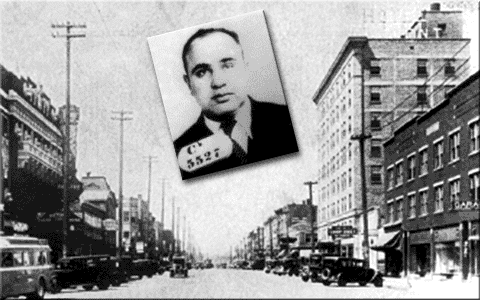
Benton Harbor and Al Capone |
Gangsters in Southwest Michigan
‘Buster from Chicago’ helps put Berrien County on the Mafia-map
Historians have neglected the role played by Berrien County, Michigan, in the history of Chicago and New York organized crime. The Berrien cities of Benton Harbor and St. Joseph were linked to three significant incidents in American organized crime history.
The first was the murder of powerful Chicago Mafia chieftain Antonio Lombardo in 1928. The St. Valentine’s Day Massacre in the Windy City also was linked with Berrien County. Both of those events had prolonged and broad reverberations. Benton Harbor was, moreover, linked to a young Mafia figure only known until now as “Buster from Chicago.” His impact on the future course taken by the American Mafia was arguably still more important.
Away from the big-city spotlight, regional underworld characters utilized Berrien County for several purposes, ranging from its use by Prohibition period figures in leisure activities, through to deploying the area as a safe place in which to dispose of a body, and as a base for moonshine liquor production.1
It was written in Benton Harbor for instance that Al Capone, “on occasion decides to either hide out locally or enjoy the summer time enjoyments of this locality.”2 The News-Palladium complained, “Capone’s presence has become so matter-of-fact here that the local citizenry, refusing to get excited about the proximity of one more headliner, has ceased to pay much attention to the comings and goings of Capone’s fleet of 16-cylinder sedans.”3 As if to underline its rest and recuperation function for organized crimesters, Capone, “as a farewell to his friends before his departure Friday for a stay in Leavenworth Penitentiary,” arranged his going-away party in 1931 at the Hotel Vincent in the city.4
Antonio Lombardo’s Killing
Violence inevitably followed from this association, with Chicago mob warfare at the epicenter. The body of a young and well-dressed Italian man shot through the head by an automatic revolver was found on September 9, 1928, face down on the shore of Lake Michigan at Hagar Township, a rural area near Benton Harbor. A Chicago-stolen and burnt out sedan was found a short distance away. All identification marks had been removed from the car, and the victim bore no identifying papers.
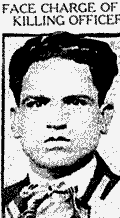
LombardoThe prevailing theory was that he had been “taken for a ride,” in retaliation for the murder of Tony Lombardo. The dead man’s build and clothes matched a description given to one of those used in the assassination. Furthermore, a blue steel gun found with the body was similar to one seen in the hand of one of Lombardo’s murderers.5 Lombardo had been slain near the busy intersection of Madison and Dearborn Streets.6 “Two men fell in step behind him, pulled out .45-caliber revolvers, and fired dumdum bullets into his head.”7 Joseph Ferraro, one of his two bodyguards, died a day later of the wounds he sustained. The shooters disappeared in the crowds. |
Born 1891 in Galati Mamertino in the Messina region of eastern Sicily, Lombardo was identified as the “capo” (head) of the Chicago Mafia after the death of Mike Merlo in 1924. Second in command was Joseph Aiello.8 Aiello was Lombardo’s partner in moonshine supply racket, selling sugar and other alky paraphernalia to home distillers. Crucially, Lombardo was allied in the mob with Capone, and was said to represent Capone’s interest in the immigrant mutual aide society, the Unione Siciliana.
The Lombardo-Aiello partnership was broken by 1927, and Aiello was openly challenging Lombardo for control of the Unione.9 The struggle that developed supplied a strong motive for Aiello to order Lombardo’s assassination. Additional motive may have been afforded by the apparent Capone-sponsored murder, in July 1928, of Calabrian powerhouse Frankie Yale in Brooklyn.10
Notwithstanding these dynamics and line of investigation, the identity of the underworld victim found in Hagar remains as elusive as ever. But in a postscript, the estranged wife of Frank Biege, the “personal executioner” to Capone, told the Chicago District Attorney in 1929 that Capone had ordered her husband to “do a job” in Benton Harbor. However, she continued, that they instead fled to New Orleans, and the contract was never fulfilled.11
Fred “Killer” Burke
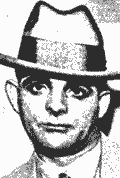
Aiello |
Capone’s counter-attack for the murder of his friend Lombardo, and for similar infractions, was savage and unprecedented in scale, even by Chicago standards. Late in 1927, Joseph Aiello exited the Windy City. Until mid-1929, he operated in Chicago only by proxy and through an alliance with the Bugs Moran gang. The Morans had repeatedly attempted to shoot Capone’s chief triggerman, Jack McGurn, and were accused of hijacking Capone whiskey trucks in Indiana. To settle scores with the Aiello-Moran combine, believed responsible for Lombardo’s downfall, Capone devised a plan to eliminate the Morans.
On the morning of February 14, 1929, four of Capone’s men walked into the S.M.C. Cartage Company garage at 2122 North Clark Street, Chicago, after observing Moran gang members there. Acting the part of raiding police officers, the Capone gunmen disarmed their opponents, lined them up against a wall and opened fire. The Moran men, “literally torn to pieces by the withering crossfire, crumpled to the floor.”12 All except Frank Gusenberg died immediately; he lingered for three hours before succumbing to his wounds.
The case moved to Berrien County, when St. Joseph traffic Patrolman Charles Skelly was slain on the night of December 14, 1929, as he tried to intervene in a minor traffic dispute. A drunken Fred Burke shot Skelly three times after Skelly jumped on the running board of Burke’s Hudson coupe and instructed him to drive to the police station to resolve the matter. Burke apparently feared identification, since he was wanted for bank robbery and murder in Ohio.13
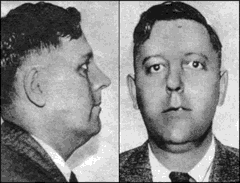
Fred “Killer” Burke |
Skelly’s murder prompted, “the greatest hue and cry and manhunt that Berrien ever knew and which attracted nationwide attention.”14 Registration records found in Burke’s abandoned car led police to a “luxuriously appointed” South Lakeshore Drive hideout south of St. Joseph, where stolen bonds and several firearms were discovered.15 Among the weapons were two Thompson machine guns, one of which was identified in Chicago as used to shoot James Clark in the Massacre. Moreover, Burke was known to pose, like the Massacre gunmen, as a policeman during the heists in which he partook.16 Burke “became the most wanted man in America, his mug shots gracing the front pages of newspapers from coast to coast.”17
Burke was born 1893 in Kansas as Thomas A. Camp. He spent his formative years in Kansas City, “eventually graduating into burglary and armed robbery.”18 Starting off by selling phony land deeds, Burke was better known to the authorities in several states for a string of heists and robberies he pulled from 1923, occasionally dabbling in kidnappings for ransom.
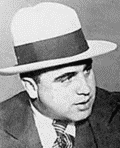
Capone |
In March 1931 Burke was captured in his father-in-law’s farm in Green City, Missouri, and extradited to Michigan to face trial, as “America’s most dangerous killer.”19 Burke’s arraignment “took only a few moments but they were probably the most dramatic ever recorded in a Berrien court.” On April 27, 1931, his crime was reduced in Circuit Court to second-degree murder, when Judge White heard that Burke was drunk when he killed Skelly. Jailed for life with hard labor in Marquette Prison, Michigan,20 Burke died there on July 10, 1940, of a heart attack without ever admitting his role in the Massacre.
The St. Valentine’s Day executions signaled the end of the Moran gang as rivals for power with Capone. Without Moran’s support, Aiello was isolated by the time he was mown down by Capone’s order in October 1930. The murders of February 14, 1929, marked a turning point in the previously tolerant attitude of the Chicago public towards inter-gang atrocities.21 Pressure was placed on the federal government to put Capone away, with the Bureau of Internal Revenue assigned to spearhead the campaign. In October 1931, Capone was jailed for 11 years and fined for tax evasion. Released in 1939, he retired to his home in Palm Island, Florida, and died in January 1947.
Sebastiano ‘Buster from Chicago’ Domingo 22
Yet from 1929 to the fall of 1931, Capone was head of the most powerful syndicate in Chicago. Capone’s supremacy was exploited by New York Mafia big shot “Joe the Boss” Masseria as part of a broader design to extend his influence in the Mafia. Masseria’s campaign caused a backlash from other crime families, the rebels headed by Salvatore Maranzano, setting the stage for the “Castellammare War.” According to the U.S. Senate’s interpretation and that shared by a number of others, Maranzano’s victory in the Castellammare War “eventually involved mobs of Italian extraction throughout the United States and it led directly to the evolution of syndicated crime.”23
Maranzano’s followers were chiefly, like Buster from Chicago to which we turn, from the western Sicilian town of Castellammare del Golfo. “Buster was undoubtedly the number one killer in the Maranzano organization,” Chandler stressed, “and he drew all the important hits.”24 His significance was deeper. Without Buster, Maranzano may have not won the War, and could not have then ushered in a “new” Mafia organization, La Cosa Nostra (the LCN), that challenges law enforcement to this day.
Yet paradoxically, Buster has been one of the most mysterious identities in U.S. Mafia history. Ralph Salerno the NYPD’s former organized crime expert, like every other commentator, contended that the real name of Buster “is still unknown.”25 A number of attempts to correct this deficiency have fallen flat.26
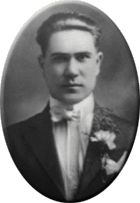
Tony Domingo |
Until 1983, insufficient detail existed to permit an accurate identification of Buster.27 Former Mafia boss Joseph Bonanno gave the game away when he identified Buster as “Bastiano Domingo.”28 During the Castellammare War, “Bastiano, or Buster, was the quickest to set up and the best shot among us. He could shoot from any angle and from any direction. His specialty was the machine gun, with which he was a virtuoso.”29 Once this information emerged, extended research filled in the blanks, leading to Benton Harbor.
Sebastiano (“Bastiano”) Domingo was born 1910 on Senna Street, Castellammare del Golfo, the son of a farm worker, Giuseppe Domingo, and Mattia (or Matilda) Farina.30 First in the Domingo clan to make the journey to New York was the eldest son, Tony Domingo,31 in 1910. New York port records showed Sebastiano, aged 3, his brother, sister and widowed mother, Mattia Farina Domingo, entering New York harbor on October 22, 1913.
The Domingos were headed for Tony’s residence in Chicago’s Oak Street neighborhood, a section “known as Death Corner because of the large number of shootings, stabbings, and murders that were committed there.”32
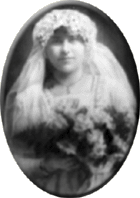
Mary Domingo |
In following years, agricultural opportunities and real estate developments drew in many Italians to Berrien County from Chicago.33 But other Italians, perhaps including the Domingos, moved to escape the Chicago variant of the “Black Hand.” Extortionists, usually themselves of immigrant stock and operating in small bands or alone, targeted the more prosperous of their paesani for blackmail, threatening a bombing if their demands were unmet. Chicago was one location where the shakedown operators were especially active.34
Whatever their reason for settling in Berrien, the Domingos and their kinsfolk became deeply embroiled in the local bootlegging traffic over the course of the 1920s. Within the Italian section of Benton Harbor, nicknamed “Brooklyn,” a largely self-contained alcohol manufacturing and selling community existed, staffed by Domingo relatives by marriage,35 the DiMarias and the Ciaravinos. They were, like the Domingos, from Castellammare, and functioned as major bootleggers in the area.
The business of supplying thirsty customers with liquor changed. “In place of the small still operated by the individual moonshiner,” the Wickersham Commission noted in 1931, “there are plants of a capacity fairly comparable to the old-time lawful distillery and all gradations.”36 Berrien County distilleries helped serve both local and Chicago markets. In August 1929, for instance, five Sicilians transporting booze to Chicago were arrested and a plant was seized on the St. Joseph River.37 The Domingos and their kinsmen appear to have focused on neighborhood sales.
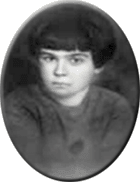
Matilda Domingo |
Tragedy awaited the Domingo extended family in Berrien County. Matilda Domingo, the six-year-old daughter of Mary and Tony, was accidentally shot dead by a single bullet fired by her 10-year-old uncle Leo DiMaria on the last day of 1925. They were alone in the Riford Street home of Stefano and Katherine DiMaria, Leo’s parents, when Leo “discharged a .38-caliber revolver he found hidden among the cushions of a davenport.” A “Chicago visitor” had left the gun in the house.38
On August 24, 1926, Sam and Frank DiMaria lost their lives when they fell into a distillery vat containing acid fumes. The plant, hidden in a barn, was one of the largest yet uncovered in Berrien County. As events were reconstructed, Frank tried to pull out Sam, but had succumbed to the fumes that killed his brother. “Then there was an appalling silence and frantic cries no longer came from the interior of the huge circular container.” At the rear was another alcohol producing installation.39
The Ciaravino family shared the DiMaria’s appetite for bootlegging revenues. Tony Ciaravino was sentenced in 1924 to up to a year for a liquor violation. His brother Gaspare “Jasper” Ciaravino pleaded guilty in February 1926 to a similar offense and was jailed for six months.40 It was his third such conviction; in 1922 and 1924, Gaspare was sentenced for offenses under the Prohibition laws.
As an alcohol-related feud erupted in April 1929, Carlo Ciaravino’s head was blown off at close range in his sleep.41 Carlo was the brother-in-law to Mary Domingo.
Late in April 1927, Prohibition agents announced “the biggest liquor haul ever made in Berrien County, and one of the largest in the state.” Leo Ciaravino, Gaspare’s son, owned the biggest plant, featuring three stills capable of producing 240 gallons of liquor daily. At Tony Domingo’s farm, an 80-gallons distillery was uncovered, along with 18 gallons of liquor and 2,000 gallons of alky manufacturing mash in barrels.42

Driving back from Benton Harbor to their farm, Mary Domingo was blown apart on October 22, 1927, when a bomb planted in the Ford coupe she was driving exploded. The car belonged to her husband Tony, the likely target of the bombing. Detectives revealed that the explosive had been wired to the manifold under the car’s hood. Mary’s body was found fifteen feet away from the destroyed vehicle, “a flaming heap of wreckage.” She was “mutilated almost beyond recognition.”43
Newspaper accounts described the dramatic aftermath. Tony and his brother Sebastiano opened fire in the Fourth Ward Republican Club while looking for Mary’s alleged assassin, Louie Vieglo. Vieglo escaped through a back door. Shooting carried on in nearby streets and the two men were finally arrested while looking for Vieglo at his store. Vieglo had fled in a stolen car, and was not heard from again. His wife told of how Tony Domingo had blamed her for his estrangement from Mary and how the families had not spoken for a year.44 Vieglo and Tony Domingo had once been in business together.45 Tony and Sebastiano were released the following day.46
‘Buster’ Heads East
Tony Domingo sold his Riverside Road farm in Hagar Township and in 1928 moved back to Chicago where he shared Mary’s fate. On August 29, 1929, he was eating in an Ogden Street restaurant owned by Pasquale Spilotro (father of celebrity Chicago-Las Vegas gangster Tony “The Ant” Spilotro, depicted in the motion picture Casino), when an assassin shot him dead.47 The Cook County coroner heard how Tony had his back to the door of the restaurant when nine shots were fired into his body from the street. Nobody saw the gunmen, but the revolver reports were heard.48 Sebastiano was mentioned only once during the inquest proceedings, as Tony’s brother who met him in front of a West Erie Street candy store “for the past several weeks.”49
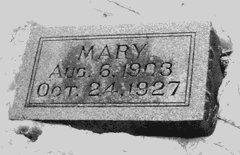 The News-Palladium declared that Tony’s “vow to avenge the dynamite death of his wife … must remain forever unfulfilled.”50 Although Tony’s murderers were never caught or prosecuted, Sebastiano purportedly believed that Capone was behind his death, furnishing a powerful reason for his eagerness to join in a Maranzano led war against the Capone-Masseria alliance.
The News-Palladium declared that Tony’s “vow to avenge the dynamite death of his wife … must remain forever unfulfilled.”50 Although Tony’s murderers were never caught or prosecuted, Sebastiano purportedly believed that Capone was behind his death, furnishing a powerful reason for his eagerness to join in a Maranzano led war against the Capone-Masseria alliance.
As of April 1930, Sebastiano Domingo had moved to New Castle Township, in Westchester County, New York, nearer to the upcoming Castellammare War fighting in New York City.51 Surrounded during his formative years in America with a high level of lawlessness and violence in both Benton Harbor and Chicago, and with the advantage of being able to gun down Masseria members in New York without recognition, Domingo was an excellent addition to the Maranzano stable of shooters. Domingo’s skill in the use of a revolver and shotgun proved decisive. Within months, Masseria was suing for peace. It did Masseria no good – his own men betrayed and killed him in a Coney Island restaurant on April 15, 1931, a move that left Maranzano temporarily in command of the U.S. “honored society.”52
As other sources mistakenly assume that Buster’s life left no trace, they wrongly claim that there is no record of Buster’s murder.53 Yet the New York press openly reported the death of “Charles Dominico,” confirmed by his death certificate and headstone as Sebastiano Domingo.
On the night of May 30, 1933, four armed men burst into the Castle Café at 72 East First Street and opened fire on those playing cards. When the gun smoke cleared, Domingo was dead and five others were wounded, one (Salvatore Ferrara) subsequently also dying. According to an eyewitness, one of the gunmen shouted, “You bunch of rats,” before shooting. The assassins ran outside and vanished.54 The Domingo and Ferrara funerals on June 3, 1933, attracted over 200 people, including friends and relatives.55
Conclusion
The events described were inter-connected. The Lombardo homicide and its sequel, the St. Valentine’s Massacre, catapulted Capone into a position of pre-eminence in Chicago. Capone’s participation arguably hastened the Castellammare War showdown, as Masseria assumed that Capone’s support would lead to a quick and final outcome. After switching sides to Maranzano, Capone further gained influence during the War in which Domingo was involved.
Research into organized crime history has concentrated on major metropolitan areas, neglecting their interaction with surrounding communities. The three cases presented have displayed a reciprocal relationship.
The St. Valentine’s Day Massacre’s Killer Burke and the slayers of the unidentified victim used Berrien County as a convenient location away from prying official eyes. Sebastiano Domingo’s experience was of contraband alcohol production in Benton Harbor. Ties to Maranzano’s New York faction, together with family misfortunes, took him from Michigan to fight a Mafia war with critical implications. In these guises, Berrien County is deserving of note for its important place in American underworld history.
|
|
|
|
Maranzano’s henchman Sebastiano Domingo was implicated in the key murders that decided the Castellammare War in Salvatore Maranzano’s favor. Joseph Valachi’s information was used to reconstruct Domingo’s role. • Joseph Morello was slain at about 3.30 p.m. on August 15, 1930, in an office on the second floor at 352 East 116th Street. Three men were sitting around a table when two gunmen burst in. “They paused only to take aim,” the New York Times recorded, “and then fired.” Also killed was Giuseppe Piraino. Gaspare Pollaro was seriously wounded. Above the office was the home of Mary Lima, Morello’s sister, who heard the gunfire and saw two assassins run into the street.56 Domingo told Valachi how Morello was killed.57 • The first time Valachi met Domingo was when they were stalking Manfredi Mineo and Stefano Ferrigno, top lieutenants in the Masseria outfit. Those lying in wait were Girolomo (Bobby Doyle) Santucci, Domingo and Nick Capucci. Mineo and Ferrigno were slain on the afternoon of November 5, 1930, as they came out of the courtyard of an apartment house at 760 Pelham Parkway. Ferrigno was shot through the head and neck. The back of Mineo’s head had been almost blown off. Three shooters were seen running from the scene.58 Valachi was away, “in the neighborhood,” when the murders were committed, but heard the details later.59 |
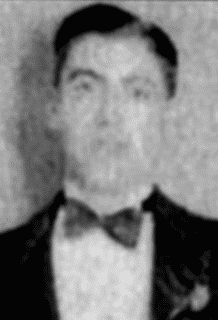 Sebastiano Domingo • Giuseppe “Joe the Baker” Catania’s death was a condition of Maranzano making peace. Valachi was the driver of the getaway car used in the murder. Domingo, Salvatore Shillitani and Nick Capuzzi conducted the execution.60 Six slugs, fired from an apartment in a building across the street, hit Catania on February 3, 1931, as he stood before a candy store on Belmont Avenue in the Bronx. Catania was another Masseria man: “Sally said he that he saw dust come out of Joe’s coat as the bullets hit him in the back.”61 • On a previously unreported mission, this one out of town, Domingo and an associate mowed down two unidentified men who had crossed Maranzano.62 |

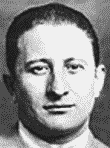
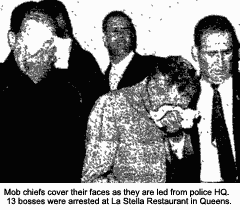 amily, as he was beginning a five-year federal sentence for perjury (another five-year sentence would be added on an additional perjury charge two years later). Antonio “Tony Ducks” Corallo’s election to the top post was delayed, as he was finishing up a prison term for bribing a city water commissioner. Racketeer Carmine Tramunti kept the seat warm as acting boss for Corallo for several years. Corallo, Lucchese’s formal successor, ran the Lucchese Crime Family empire for a decade and a half until the federal Commission trial in 1986. Corallo, already in his 70s, was sentenced to serve 100 years in prison. He died Aug. 23, 2000, at the age of 87.26
amily, as he was beginning a five-year federal sentence for perjury (another five-year sentence would be added on an additional perjury charge two years later). Antonio “Tony Ducks” Corallo’s election to the top post was delayed, as he was finishing up a prison term for bribing a city water commissioner. Racketeer Carmine Tramunti kept the seat warm as acting boss for Corallo for several years. Corallo, Lucchese’s formal successor, ran the Lucchese Crime Family empire for a decade and a half until the federal Commission trial in 1986. Corallo, already in his 70s, was sentenced to serve 100 years in prison. He died Aug. 23, 2000, at the age of 87.26